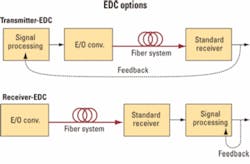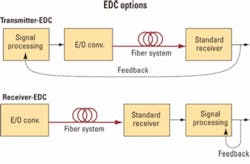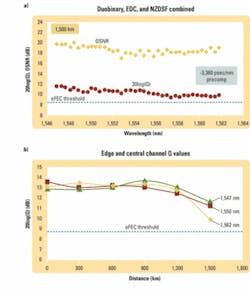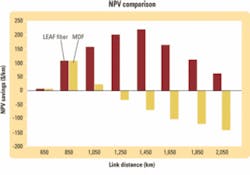Low-dispersion fiber complements dispersion-tolerant technology
By Joe Dempsey, Merrion Edwards, and Claudio Mazzali
Since the introduction of EDFAs and WDM in the early 1990s, compensation for dispersion in optical systems has been achieved by deploying passive dispersion-compensating modules (DCMs) at regular intervals along the transmission line. However, these in-line modules add to system cost and complexity; they require dual-stage amplifiers to compensate for their additional attenuation and add significant amounts of PMD. This additional PMD complicates data-rate upgrades and limits transition to transparent network operation via reconfigurable optical add/drop multiplexers (ROADMs). As a result, a network free of in-line dispersion compensation is attractive to network designers.For this reason, dispersion-tolerant telecommunications technologies have moved into the spotlight. For instance, the ability of duobinary modulation and receiver-based electronic dispersion compensation (EDC) to enable networks to operate without in-line dispersion compensation has been well publicized. These technologies and others like them are vying to become the preferred alternative for dispersion compensation.1,2
However, there is another aspect of reach extension-the fiber itself. Tests demonstrate that each of these two dispersion-tolerant techniques, when used individually over low-dispersion G.655 fibers, can extend transmission to approximately 600 km without in-line assistance. However, that distance doesn’t cover all applications-which leads to the question of what happens when you pair both techniques with G.655 fiber?
The modulation format used to encode data streams for transmission over optical networks can have a significant impact on the data stream’s tolerance to distortion due to nonlinear transmission effects and chromatic dispersion. Traditional data encoding systems in optical networks like non-return to zero (NRZ) and return to zero (RZ) are characterized by a signal with two signal amplitude levels representing the 1s and the 0s.Two modulation formats, duobinary and alternative block inversion (ABI), have been developed that display a higher degree of tolerance to dispersion-based pulse distortion than the traditional modulation schemes such as NRZ. By introducing alternative phase states as a third level of signal encoding, duobinary and ABI modulation reduce dispersion-induced intersymbol interference and yield greatly increased dispersion tolerance.
Duobinary is more mature than ABI as a technology. With commercially available duobinary transponders, the typical uncompensated reach of G.652 fibers (80 km at 1,550 nm) can be extended to almost 200 km for 10-Gbit/sec operation.1
Alternatively, EDC is a new technology that also works to extend the uncompensated transmission reach of optical networks and is now attaining commercial maturity. EDC systems have evolved into two forms, transmitter-based (Tx-based) EDC and receiver-based (Rx-based) EDC as shown in Figure 1. Rx-based EDC uses advanced signal processing techniques at the receiver to decode signals that have been distorted due to dispersion. There are three common Rx-based EDC techniques. They are decision feedback equalization (DFE), feed-forward equalization (FFE), and maximum likelihood sequence estimation (MLSE).
Corning research has shown that DFE and FFE do not have as strong a dispersion-correction capability as does MLSE. It has been demonstrated that Rx-based EDC with MLSE can provide up to 60% reach extension when using traditional NRZ modulation and a 10% to 15% additional reach extension when using duobinary modulation.3
Looking at the wider picture it is clear to see that, if integrated, duobinary modulation and Rx-EDC have the potential to extend the reach of uncompensated systems significantly. It is expected that when integrated, these technologies will enable DCM-free transmission up to 250 km over standard singlemode fiber.
There is, however, another dimension to this story. Well before dispersion-tolerant technologies were investigated, the fiber community developed a product that delivered a considerable extension in uncompensated reach in the 1,550-nm band.
In the late 1990s, as 10-Gbit/sec transmission rates and WDM were adopted and the limitations of dispersion with multichannel operation at those data rates were realized, non-zero dispersion-shifted fibers (NZDSFs) with lower dispersion in the C-band reached the market. These products are now broadly categorized by the G.655 standard.
Both G.655 and G.652 fibers need dispersion compensation to span conventional distances in metropolitan, regional, and long-haul networks. However, a lower-dispersion G.655 fiber such as LEAF fiber has about 25% of the dispersion of a G.652 fiber. In the linear regime, reducing the fiber dispersion to 25% of G.652 fiber dispersion enables 4× the uncompensated reach-with NRZ modulation. As a result, LEAF fiber alone can enable DCM-free networks up to 320 km at 10 Gbits/sec. If we apply duobinary modulation to LEAF fiber we can nearly double the uncompensated reach to 600 km or more.4 If we combine Rx-EDC with NRZ signals transmitted over LEAF fiber, Corning research has concluded that an uncompensated reach of approximately 600 km is also possible.
Such distances will enable many of today’s optical networks to operate without in-line dispersion compensation, but still will not deliver that goal for extended-reach networks. What if we integrate both EDC and advanced modulation formats with NZDSF? Can we finally offer the possibility of WDM optical transmission free of in-line dispersion compensation to extended-reach optical networks?
To answer this question, Corning has studied the performance capabilities of using a lower-dispersion fiber with the new dispersion tolerant technologies. Research at Corning’s Sullivan Park research laboratories has demonstrated 10.7-Gbit/sec transmission of 38 channels with 50-GHz spacing in the long-wavelength half of the C-band (worst case condition) using duobinary modulation and MLSE Rx-based EDC over 900 km of LEAFfiber without using any optical dispersion compensation.4,5 Further studies have shown that with the use of one optical precompensation module at the transmitter with fixed precompensation of -3,360 psec/nm at 1,550 nm, this distance can be extended to 1,500 km without any in-line or post-compensation as shown in Figures 2a and 2b.5
At 1,500 km, the system is dispersion-limited by the longest wavelength channels, which have the greatest accumulated dispersion. However, it is noteworthy that the system performance is relatively flat with distance out to approximately 1,200 km across all channels, such that any channel can be dropped at any distance up to 1,500 km without receiver modifications. This feature is highly advantageous for transparent and reconfigurable optical networks.Clearly, by enabling optical transmission free of in-line dispersion compensation over the majority of networks, the integration of duobinary modulation with Rx-based EDC over low-dispersion G.655 fiber is an exciting concept. But with the acute focus on cost management in optical system development, is the cost of this new technology when used on G.655 fibers at a level that will encourage wide-scale adoption?
To understand the cost versus savings implications of the application of Rx-based EDC with duobinary over a lower-dispersion G.655 fiber at 10 Gbits/sec, Corning has compared the cost of such a system when installed using fibers with various dispersion levels (LEAFfiber, a G.656-compliant MDF, and G.652 fiber). Many new approaches can often be discounted on initial evaluation due to their slightly higher first installed cost (FIC). Indeed, duobinary transponders currently have a 10% to 15% cost premium over traditional transponders.1 However, consideration is often not given to the fact that new approaches can deliver continual savings over the lifetime of the network. For example, Rx-based EDC and duobinary on a lower dispersion fiber will save on DCMs every time a new fiber is lit to deliver a capacity upgrade.
To account for this, a net present value (NPV) model is used that not only considers the FIC, but accounts for all future additional capital expenditure savings that occur when DCMs are not required when additional fibers are lit. To deliver a balanced view of the overall cost comparison of each fiber type, the cost of future capital expenditure on DCMs is translated back to current monetary value. In addition, to isolate and better understand the cost savings impact related to DCMs alone, the impact of any amplifier savings is not considered in this model. Although in practical systems the DCMs are usually evenly distributed along the link, to make interpretation of the results simpler and more straightforward, the model assumes that each different fiber type requires the first in-line DCM only after the maximum uncompensated reach, so for LEAFfiber it would be at 1,500 km, while for the MDFs it would be at 900 km and after 450 km for high-dispersion G.652 fibers.
The results of the analysis are shown in Figure 3. After 450 km G.652 fiber begins to require DCMs and as a result LEAFfiber and MDF savings from DCM elimination show positive NPV relative to G.652 from 650 km onward. For MDF the NPV increases up to 900 km, but then MDF itself begins to require DCMs and the NPV savings rapidly adopt a negative trend. In contrast, the low dispersion of LEAFfiber allows the NPV savings to grow all the way up to 1,500 km; from there the strength of the previous NPV savings allows positive NPV to be maintained up to 2,500 km. This analysis shows that for networks up to 2,500 km, duobinary modulation with Rx-based EDC over LEAF fiber can deliver significant cost savings.
Dispersion-tolerant technologies like duobinary modulation and Rx-based EDC have gained significant media attention in 2006. These technologies have important implications for the future development of uncompensated short-reach networks and are now maturing with duobinary products available from multiple companies.
But what about longer-reach networks, where progression toward transparent networks will greatly benefit from DCM-free transmission? With low-dispersion NZDSF, the integrated application of duobinary modulation with Rx-based EDC can deliver 1,500 km of transmission reach without any in-line dispersion compensation and with attractive cost savings. So finally the goal of cost-effective extended-reach transmission without any in-line dispersion compensation can be achieved, which translates into a significant advantage for transparent and reconfigurable networks.Joe Dempsey is assistant product line manager, advanced products; Merrion Edwards is manager, market development; and Claudio Mazzali is manager, market development and advanced products at Corning Incorporated (www.corning.com).
* LEAF is a registered trademark of Corning Incorporated.
1. S. Hardy, “Optical Duobinary Promises Improved Reach, Greater Flexibility,” Lightwave, p. 1, May 2006.
2. S. Hardy, “Dispersion Tolerant Technologies Battle for Attention,” Lightwave, p. 1, June 2006.
3. J.D. Downie, M. Sauer, and J. Hurley, “Experimental Measurements of Uncompensated Reach Increase from MLSE-EDC with regard to Measurement BER and Modulation Format,” Opt. Express 14, pp. 11520-11527, 2006; www.optics infobase.org/abstract.cfm?URI=oe-14-24-11520.
4. J.D. Downie, M. Sauer, and J. Hurley, “Flexible 10.7Gb/s DWDM Transmission over up to 1200km without Optical In-Line or Post-Compensation of Dispersion using MLSE-EDC,” 2006 OFC/NFOEC, Presentation JThB5.
5. J.D. Downie, M. Sauer, and J. Hurley, “1500km Transmission over NZ-DSF without In-line or Post-compensation of Dispersion for 38×10.7Gbit/s Channels,” Electron. Lett., Vol. 42, No. 11, May 25, 2006.




